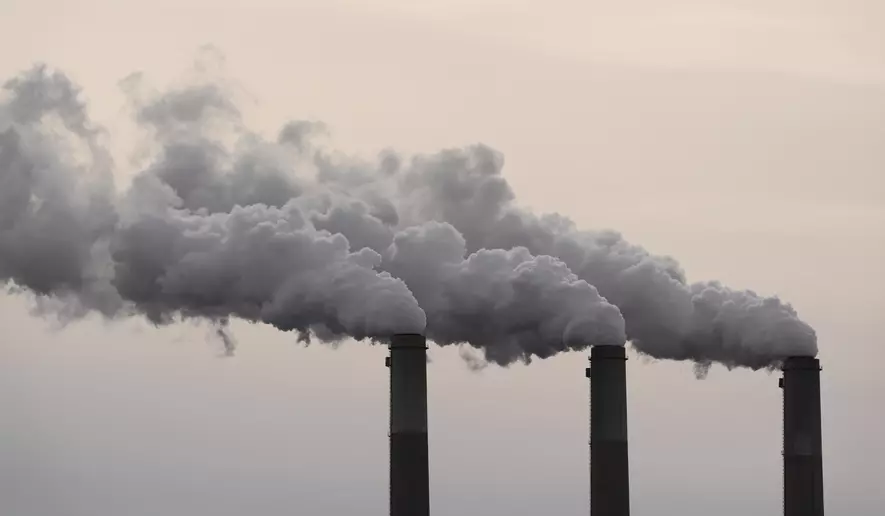President Trump has thrown a lifeline to the nation’s fleet of coal-fired power plants, which have been on a steady decline for decades as Democrats worked to shutter them entirely over environmental concerns.
While President Biden imposed regulations that would force the closure of nearly all U.S. coal plants by 2039, Mr. Trump is reversing course. His administration announced a string of new policies aimed at keeping the plants open and restarting some dormant coal plants as part of an effort to surge energy production and make the U.S. more competitive globally.
“We see this as the beginning of a major coal renaissance in this country,” said Chris Hamilton, president of the West Virginia Coal Association.
Roughly 210 coal-fired power stations remain in use in the U.S. and many were slated for retirement.
Mr. Hamilton said following Mr. Trump’s pledge to revive coal, more than 40 coal-fired power plants previously scheduled for closure this year now plan to remain open.
“Right here in our little state of West Virginia, we are taking measures as we speak to upgrade and retool these coal-fired generators so that they can run for many more decades and produce baseload electricity,” he said.
Mr. Hamilton credited the Trump administration for moving quickly to lift Biden- and Obama-era regulations that would have largely brought an end to coal-fired power plants within the next decade.
Environmental Protection Agency Administrator Lee Zeldin announced earlier this month plans to scrap the Biden administration’s power plant rule, which would have forced coal plants to shut down unless they met a currently impossible goal of cutting emissions by 90%.
The EPA is also reconsidering strict emissions standards for mercury, acid gasses and other pollutants emitted by coal-fired power plants as well as tough regulations on water pollution and coal ash associated with the plants.
Trump administration officials say lifting the restriction on coal will keep more plants online and allow some recently closed plants to reopen, which will help maintain the stability of the electric grid in the face of skyrocketing energy demands.
“What we saw during the Obama and Biden administrations was a deliberate effort to try to regulate coal and other forms of energy out of existence,” Mr. Zeldin told The Washington Times. “That is the opposite of what we should be doing right now. Americans are desperate to be able to afford energy, and coal is a big component of the energy supply in many parts of this country. President Trump and EPA will do their part to deliver.”
The coal revival, however, will have to survive a mountain of lawsuits by environmentalists who argue that coal is a big polluter and major contributor to climate change.
Energy from coal has been on a steady decline in the U.S., dropping to roughly 15% of the U.S. energy mix last year, down from 25% of U.S. electricity production in 2020 and nearly 50% in 2008.
In 2022, renewable sources — wind, solar, hydro, biomass and geothermal — surpassed coal-fired generation in the power grid for the first time.
Before the EPA’s deregulation announcement, one-third of the nation’s coal-fired power plants were expected to close over the next five years.
Environmental regulations imposed during the Obama administration played a significant role in forcing the retirement of 48 gigawatts of coal-fired power during Mr. Obama’s eight years in office. One gigawatt can power up to a million homes.
Mr. Trump tried to revive the industry during his first term, but the Obama regulations, along with Obama-era subsidies for renewables, continued to hurt the coal industry and plants producing nearly 40 gigawatts were shut down before Mr. Trump left the White House.
Competition from increasingly abundant and cheaper natural gas also played a role in reducing coal’s slice of the nation’s energy grid.
The loss of coal plants, as well as efforts by Democrats to reduce production from natural gas-fired plants, has led to warnings from energy regulators that the electrical grid is becoming increasingly prone to brownouts and blackouts.
Democrats sought to transition the U.S. power grid away from fossil fuels by substituting renewable energy, such as wind and solar. But renewables are intermittent sources and cannot produce enough power to fill the void left by cutting out fossil fuels, including coal.
Coal has remained a major part of the U.S. electrical grid, providing baseload energy to the country’s increasing demands.
“One of the things certainly that has changed the dynamics for the pace of the grid transition is exploding energy demand,” said Michelle Bloodworth, president and chief executive officer of America’s Power, which represents coal electricity and its supply chain.
Ms. Bloodworth said the Trump administration “understands the need for flexible and sensible environmental regulations.”
Mr. Trump’s coal revival aligns with his pledge to make the U.S. the leader of a global technology revolution centered on artificial intelligence. New data centers needed to fuel the technology will require a massive build-out of new energy production. Existing data centers are already straining power grids and leading to delays in closing coal plants.
Mr. Trump, posting on Truth Social earlier this month, warned shutting down American coal plants during the past two decades has allowed China, a main competitor in AI technology, to gain “tremendous economic advantage” over the United States.
While the U.S. has experienced a reduction in coal-fired power plants and has not built a new one in more than a decade, China, India and other developing nations are rapidly adding them to their power grids.
China has built two coal-fired power plants per week for the past several years and uses nine times as much coal in its energy sector as the U.S., according to the Institute for Energy Research. India is also rapidly building coal plants, adding 4 gigawatts of coal-fired power in 2023, enough to power 4 million homes.
Coal-fired generation in India rose by nearly 15% in 2023, the IER reported.
Mr. Trump’s coal revival plans face a wall of lawsuits by environmental groups who oppose lifting regulations that reduce pollution and emissions they said are causing health hazards and dangerous climate change.
The environmental law organization Earthjustice said it will sue EPA “for gutting rules to safeguard our health, air, water and climate,” and boasted the organization “previously successfully defended many of these safeguards in court and will do so again.”
Environmental groups say coal-fired power plants account for 20% of the nation’s carbon dioxide emissions from fossil fuels and pollution from the plants is linked to asthma, cancer, heart and lung ailments and acid rain.
Ms. Bloodworth, who represents the coal electricity producers, said the industry has invested $70 billion over the past two decades in advanced environmental controls to make the plants as clean as possible.
A handful of coal-fired plants are also investing in carbon capture and storage, which removes carbon dioxide emissions and stores them underground. But the emerging technology is costly and requires underground pipelines and other infrastructure. There are no coal plants that use commercial-scale carbon capture and storage as the industry worries it will be forced out of business under crushing regulations.
“The biggest way to incentivize capital investments in coal plants, including carbon capture and storage, would be to provide sufficient assurances that future environmental regulations will not force the retirement of existing plants over the next decade,” Ms. Bloodworth said. “Utilities want to know if they make that investment, they can recover those costs. That’s the best approach certainly for consumers and the economy.”



